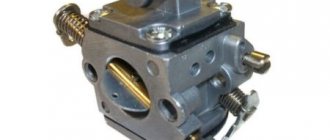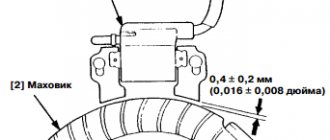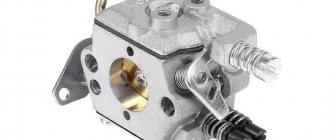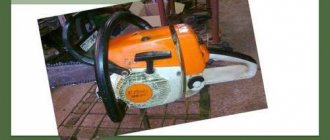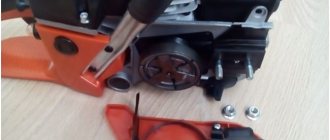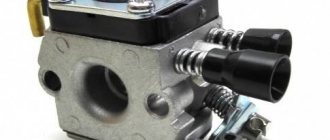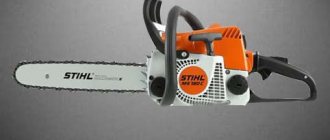When should it be adjusted?
First, you need to decide why you might need to adjust and repair the Stihl ms 180 carburetor. So, this needs to be done in the following cases:
- If the chainsaw does not hold idle speed;
- repairs may be required if the saw does not start;
- there is a loss of power;
- increased fuel consumption;
- the chainsaw does not develop maximum speed;
- stalls when revving up.
This list can be continued for a long time, but we have identified the main reasons. Before you start making adjustments, you need to know what main parts the carburetor on the Shtil MC 180 chainsaw consists of, and who makes it.
To sum it up.
In fact, as you can see, there are quite a lot of reasons for the breakdown of the Shtil 180 chainsaw, and at the same time, there are also quite a few solutions to this problem. If you are faced with this situation, then simply follow all the recommendations written above and then, undoubtedly, you will be able to repair your device, and it will delight you with its work for many years to come.
Read:
In fact, as you see the causes of chainsaw collapse, Stil 180 is quite a lot, and at the same time, the solutions to this problem are just as good. If you are faced with such a situation, just follow all the above recommendations and, undoubtedly, you will be able to restore your device and it will delight you with your work for many more years.
How to adjust it yourself, the nuances of setting
The carburetor of the Shtil 180 chainsaw, indiscriminately, can only be adjusted by the number of revolutions at idle. It is impossible to increase or decrease the fuel supply in various modes using special screws. The manufacturer limits access to adjustments and does not install these screws. How to adjust the carburetor to the correct idle speed is described in great detail in the manufacturer's instructions.
If certain malfunctions occur, and if you have experience, you can increase or decrease the fuel supply by increasing the gap when opening the needle valve.
To increase the flow, the rocker arm of the needle valve in the distribution chamber must be bent up, and to decrease, down. This regulates the stroke of the needle and, accordingly, the throughput of the valve.
You should not carry out the adjustment yourself, because this must be done very precisely and if there is an error, it is almost impossible to return the original position of the rocker arm.
Malfunctions and repairs
After we have examined the design of the carburetor, it is not difficult to determine the reason why fuel enters the combustion chamber in a larger volume. This happens due to wear of the gasket between the compensator cover and the carburetor body. How might this make an impact, you ask?
The answer is simple: as the gasket contracts, it releases the diaphragm on top of it a fraction of a millimeter down. This, in turn, will put more pressure on the needle valve rocker arm, it will open more than it should and fuel will flow in excess (it will begin to overflow).
Another reason is stretching of the diaphragm itself, this occurs as a result of natural wear and tear. It is impossible to prevent this process, but you can solve the problem by periodically changing all gaskets, carburetor diaphragms, and fuel pumps. There is a repair kit for this.
When cleaning a chainsaw with compressed air, never blow into the fuel pipe, as this can stretch the diaphragm.
Sticking injector valve - a common breakdown and how to avoid it?
A common cause of carburetor failure on a Stihl chainsaw is a stuck valve in the nozzle. The reason for sticking is a violation of the storage of the chainsaw, or rather the Shtil 180 manufacturer’s instructions for proper preparation for storage.
As follows from the instructions, before long-term storage, it is necessary to drain the fuel from the tank, then start the saw and burn off the gasoline from the carburetor. Failure to comply with this elementary rule entails the following consequences. The forsknui valve, being in direct contact with the fuel, sticks to the body, because the gasoline gradually evaporates and only sticky oil remains. You cannot replace the injector, since they are not in the repair kit; you can only try to knock it out and wash it, which is not always possible to do without damaging the injector.
Checking the ignition system
Chainsaw ignition system
If the tool does not start, the problem may lie in the trigger mechanism or ignition system. If the starting device is working normally, then it is necessary to carefully inspect the spark plug. It needs to be unscrewed and carefully inspected.
Particular attention here should be paid to the electrodes, on which plaque may accumulate. If there is a red-brown coating on the electrodes, this indicates serious malfunctions of the entire starting system
So, the cause of the malfunction may lie in the carburetor.
If the ignition system works normally, but the tool does not work correctly, then the problem may be due to an excess of air-fuel mixture. Here you need to adjust the carburetor and clean the jets.
Do-it-yourself chainsaw carburetor adjustment
If during the inspection, carbon deposits were found on the spark plug, this means that the tool runs on low-quality gasoline. This may also be due to improper functioning of the carburetor.
To solve this problem you need to do the following:
remove the carburetor and check it; if necessary, clean and adjust it; replace fuel; install the carburetor and check the tool in operation.
It is worth noting here that the carburetor is a rather complex unit. Therefore, if there is a need to repair it, it is better to seek help from specialists.
Attention: the chainsaw should only operate on the fuel specified in the instructions. Using low-quality fuel will lead to various malfunctions
With this information, you can repair the Shtil 180 chainsaw at home. Of course, you need to take into account that it is better to fix more serious faults in service centers.
Watch an overview video about diagnosing the lubrication system of the Stihl MS180 chainsaw:
Trimmers and chainsaws
1) Malfunctions of the STIHL MS 180 chainsaw: Gas wedges and, finally, the gas key stops moving completely. Cause: Clear translucent resin on the carburetor throttle shaft, causing the throttle to seize. Resin is formed when gasoline dissolves the defective choke coating. Chainsaw repair: The carburetor throttle body axis should be cleaned with acetone, and the air damper itself should be irradiated with tin.
2) Chainsaw malfunction: The chainsaw “does not pull.” Cause: Clogged carburetor. Chainsaw Repair: Cleaning and Cleaning Carburetor Chains
Particular attention is paid to cleaning the carburetor should be cleaned with an additional filter (grids in the carburetor chainsaw) - remove the largest carburetor cap, remove the membrane under it and clean the dirt from the mesh in the groove (careful not to lose this mesh). Of course - clean with thin copper wire, rinse and blow out all the channels in the carburetor chainsaw
3) Malfunction of the Calm 180 chainsaw: The idle speed of the chainsaw has increased (the idle speed adjustment is ineffective and unstable). Cause of malfunction: Air intake through the crankshaft oil seals or elsewhere. Chainsaw repair: Replace the crankshaft oil seals and check for other possible suction areas.
Read:
4) Chainsaw malfunction: After disassembling the carburetor, the chainsaw is difficult to start, white smoke appears from the chimney. Reason: When disassembling the carburetor, the spring is lost under the needle lever, as a result, the needle does not block the fuel supply, and the spark plug is “filled” with gasoline. Chainsaw Repair: Locate and place the spring under the needle lever in the chainsaw carburetor.
5) Chainsaw malfunction: The chainsaw does not start well, it does not work well. reason: the gasoline spark plug is “pouring” due to the sticking of the needle in the carburetor or a high-lifted rocker. Do-it-yourself chainsaw repair: Wash and bleed the carburetor, install the rocker correctly.
Read also: Small CNC machine for wood
Design and principle of operation
So, the carburetor was developed and manufactured by a subsidiary of Stihl, called Zama. Original carburetors have the company logo on their body, guaranteeing product quality.
Appearance of the Zama carburetor
Fuel pump
A fuel pump is installed directly in the carburetor body, which operates under the influence of an air pulse from the chainsaw crankcase, transmitted through special channels. The pump has a diaphragm installed, which is responsible for pumping fuel under the influence of an impulse. A gasket is installed between the diaphragm and the housing, which is responsible for the tightness of the fuel pump.
Distribution chamber
In the distribution chamber, as in the fuel pump, there is also a membrane that opens and regulates the fuel supply by pressing a special rocker arm, which lifts its needle valve.
The chamber cover is the compensator body, which is attached to the carburetor using four screws; a gasket is installed between the body and the cover, which increases the height of the chamber and is responsible for sealing.
Nozzle
The fuel supply nozzle is mounted in the carburetor body in such a way that it is a connecting link between the distribution chamber and the cavity in which the throttle valve is installed. At the same time as the fuel, air is supplied to the injector and an air mixture is formed. The injector has a check valve that blocks the flow of air in the reverse order, that is, from the throttle chamber to the distribution chamber.
Throttle valve
The throttle valve is installed in the carburetor body and is responsible for increasing the flow of the fuel mixture directly into the engine cylinder. At the moment you press the gas, the throttle valve opens slightly, thereby increasing the throughput of the channel and fuel from the carburetor cavity rushes into the cylinder in a larger volume.
Combustion of a larger volume of fuel increases the amount of energy generated, which affects the power and speed of processes. The damper is installed on a shaft passing through the entire carburetor body. At the shaft exit from the housing, there is a fastening for the throttle cable, and next to it there is a cone-shaped adjusting screw responsible for adjusting the idle speed. By tightening the screw, you can slightly adjust the position of the shaft and the damper installed on it, thereby increasing or decreasing the idle speed, slightly opening or vice versa closing the damper.
Air damper
The carburetor air damper is installed on the opposite side of the throttle valve and is responsible for starting a cold engine; it is controlled by the engine control lever. For a cold start, the air damper is completely closed; for normal operation, it is opened.
In the photo, there is a hole in the center, and there is a washer in the middle - this is the air damper
Features of the Shtil 361 chainsaw
The carburetor is the most complex functional unit used in a saw. It performs operations such as mixing the fuel with the air needed to produce an effective mixture. It is important that the amount of fuel mixed with gasoline is sufficient for normal engine operation.
The Shtil 361 chainsaw itself is a very common model of gas powered tools. There is enough engine power to build on its basis numerous other types of units. Boat motors, ice screws, and grinders are made from it. Everything is explained by a reliable internal combustion engine and an improved fuel system.
In order for carburetor repair in a Shtil or Kawashima, Magnum, MEGA, MTD, Nikkey, OMAX, Orleon, Prokraft, Prorab chainsaw to be required much less frequently, you must follow the following simple rules:
The presented model is equipped with a fairly new option - carburetor heating . It allows you to quickly and smoothly start the engine at any time of the year, as well as maintain power and eliminate the possibility of icing in severe minus temperatures. There are models of saws on which manufacturers install exhaust gas catalysts and a protective spark-extinguishing grille on the muffler.
How to remove and reinstall?
In cases where it is necessary to clean the Shtil 180 carburetor or disassemble it, you will first need to remove the assembly from the chainsaw. This must be done in compliance with a certain algorithm of actions:
- Place the protective cover for the chainsaw on the bar.
- Remove the top cover of the chainsaw.
- Unscrew the two nuts securing the air filter and carburetor.
- Remove the air filter housing.
- Disconnect the wire from the engine control lever.
- Carefully remove the lever from its seat in the housing, while simultaneously disconnecting the air damper rod from it.
- Pull the carburetor towards you and disconnect the fuel supply, as well as the throttle linkage.
To facilitate dismantling, you can additionally unscrew the rear handle and disconnect the throttle linkage first from it, and then only from the carburetor. This may be necessary, because without some experience, disconnecting the rod from the carburetor is quite problematic and it is easier to first disassemble the handle.
To install the part in place, follow the reverse order of the algorithm.
When removing and installing the chainsaw engine control lever, you should be extremely careful, because the seat on the saw body is the weak link of the saw, and very often inexperienced users break it.
Cleaning correctly
To properly clean your chainsaw, you will need the following tools:
- Phillips and flat screwdriver,
- wrenches with heads of different sizes,
- special cleaning composition, cleaning cloth,
- ultrasonic cleaner.
The set of tools can be seen in the photo.
Cleaning the carburetor of a chainsaw should be done according to the following algorithm:
- First you need to drain the remaining fuel from the fuel tank. Types of chainsaws, 3.3.1 how to remove and clean the muffler when the chain brake does not work. Remove the cover of the chainsaw by unscrewing the fasteners. We take out the filter and disassemble the housing, removing nuts and clamps if necessary.
- Remove the fuel mixture supply hose from its clamp, unscrew the fasteners of the carburetor top cover. Then remove the top cover and the blue gasket - this is the fuel pump membrane. To the left of the body there are spring clips, remove them, and then the screws. It is advisable to label the parts and schematically record the places from which they were removed, so as not to confuse anything during assembly.
- Remove the bottom carburetor cover, unscrew the screw and remove the needle valve and the spring under it. The question is: “I’m filling a spark plug on a Shtil 180 chainsaw, what should I do?” Then, using longitudinal force, remove the air damper and its axis.
- Remove the throttle valve, drive lever and throttle shaft.
- We lay out all the removed carburetor parts on a flat surface and inspect them to ensure integrity is maintained. Parts with a high degree of wear must be replaced with new ones.
- Using a specialized cleaning agent, wash the parts and dry with a lint-free cloth. The tubes must be blown under pressure using a pump.
- To achieve maximum effect, you can clean the carburetor on a Shtil chainsaw using a special cleaning bath, the basis of which is the cavitation effect. The bath is filled with diesel fuel, and the carburetor parts are immersed in it for several minutes. How to adjust the carburetor on a chainsaw. Finally, we dry the parts using a pump.
How to repair a carburetor
on
a Shtil
ms 180 chainsaw.
repair cleaning stihl carburetor
180.
A detailed video with the cleaning process will help you do the job correctly.
After all the products have been dried, it is necessary to assemble the carburetor. Usually the detergent evaporates completely within a day. It is better to wait a day after cleaning, since residual detergents on the parts can get into the fuel compartment and release toxic gases during combustion.
Another important nuance associated with disassembling a chainsaw is that it is necessary to extremely accurately install and adjust the needle valve blade, otherwise the chainsaw may not start. You can use a blade to check that the petal is installed correctly. Having installed it on top, we see how freely the petal rotates. Adjusting the carburetor on a chainsaw: how to adjust the carburetor on a chainsaw. If no problems arise, then everything is in order and you can continue assembly. If movement problems still arise, then the petal must either be pressed down or the edge on it must be bent.
How to disassemble for cleaning and replacing the repair kit?
In order to clean, change gaskets or needle valve, the carburetor must be disassembled. To do this, you need to unscrew 4 screws on the compensator cover and one on the fuel pump.
Once you open the housing, you should be extremely careful, because if debris gets inside the carburetor, it will make it impossible to operate. The thickness of the channels in it is comparable to the thickness of a thread or even a human hair.
A video on repairing a Shtil 180 carburetor can be viewed below. In it, the master talks in detail about the problems and clearly demonstrates the entire repair process.
Who can repair carburetors?
Everything said below applies to any models of chainsaws, including gas trimmers, scythes and other equipment. Adjusted, of course, for design features.
There is an opinion that it is better not to climb inside a chainsaw yourself. For those who are used to working with a hammer and sledgehammer, this may be true. Otherwise, any more or less neat person whose hands do not shake can fix any problem with his work. In general, this is a job available to anyone.
Of course, it happens that the problem cannot be solved on its own. And you need to contact the service center. But firstly, 90% of malfunctions are usually solved by simply flushing the jets or, in the worst case, replacing the membranes or adjusting the needle, and secondly, in the worst case, even if you are desperate, the carburetor removed from the saw can be easily replaced. The new original one is, of course, a little expensive. The price for an analogue made in China is 700-800 rubles, you can buy it in a well-known store or from Russian dealers. In general, there is nothing to lose - let's get into the carburetor!
